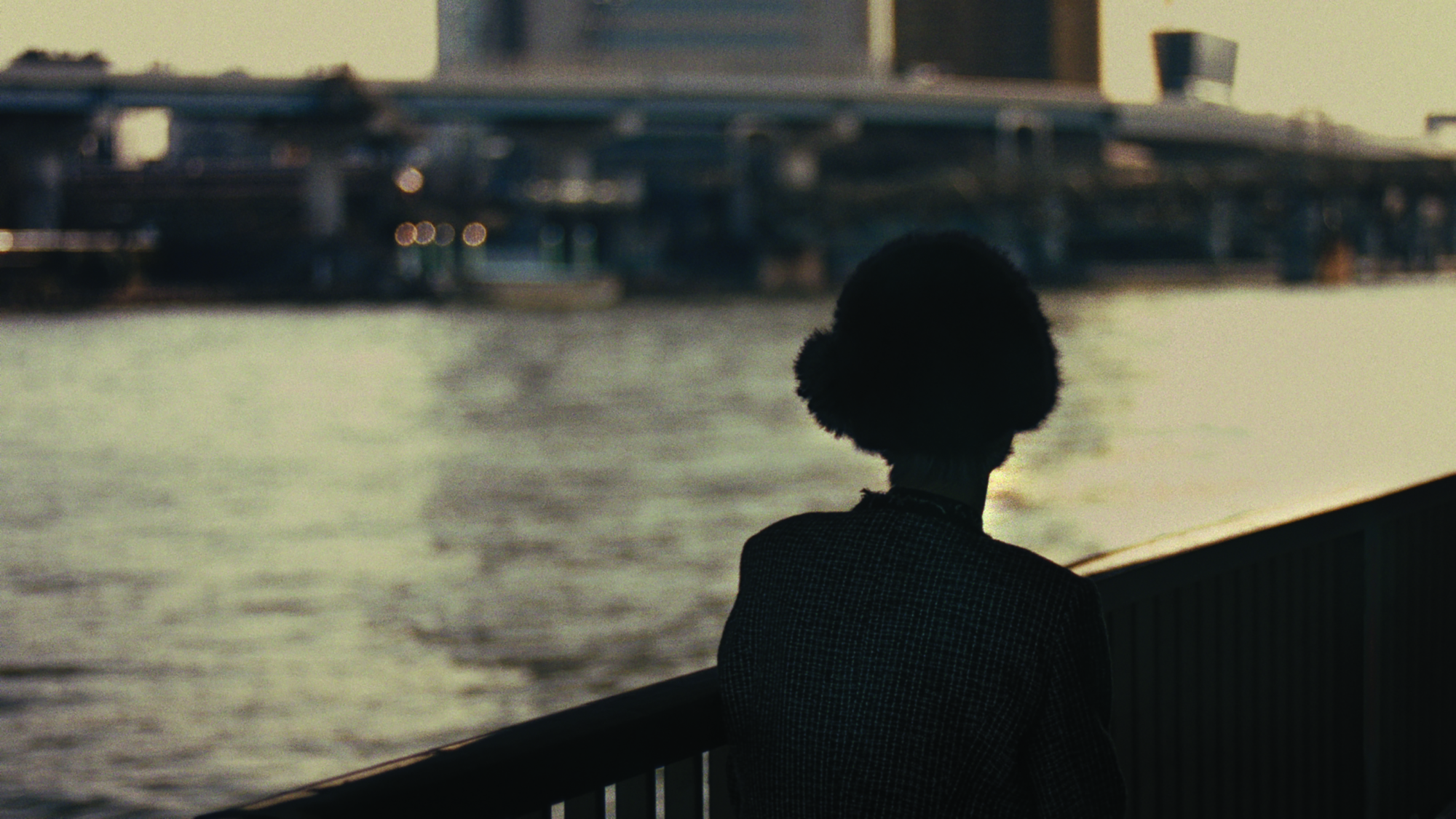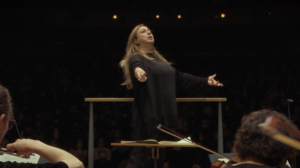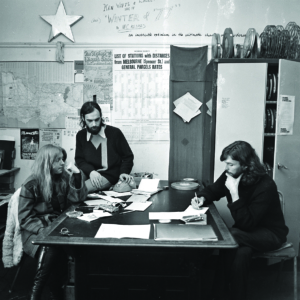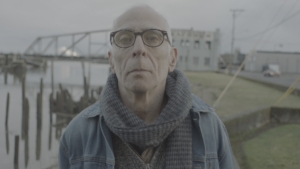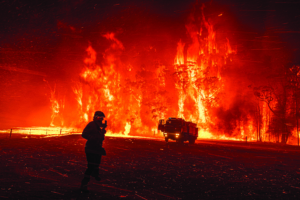A little after midnight on 10 March 1945, Tokyo residents were woken by the familiar wails of air-raid sirens. They were already accustomed to the threat of death from above, the war having gradually arrived at their doorstep in the preceding months as Japanese forces suffered defeat after disastrous defeat. But the horror unleashed on them that night was on a different scale to the previous raids. Waves of American B-29 bombers, stripped of their armaments so they could be crammed with incendiaries, scattered their cargo over the city’s working-class shitamachi district,[1]Though ‘shitamachi’ literally translates as ‘downtown’, its etymology relates to the topographically low-lying areas of the city’s east and the fact that these areas were traditionally home to lower-class citizens. a densely populated area packed with wood-and-paper dwellings. By dawn, roughly a quarter of the capital had burned to the ground. An estimated 100,000 civilians – mostly women, children and the elderly[2]The over-representation of these demographics is due to the fact that most fit young men had been enlisted to fight in the war and were not in the city at the time. See Robert D Eldridge, ‘The March 1945 Firebombing of Tokyo and the Immorality of War’, The Japan Times, 9 March 2020, <https://www.japantimes.co.jp/opinion/2020/03/09/commentary/japan-commentary/march-1945-firebombing-tokyo-immorality-war/>, accessed 9 August 2021. – were killed, a million others left homeless. The pilots would later recall being nauseated by the stench of burning flesh that reached their cockpits.[3]See John Ismay, ‘“We Hated What We Were Doing”: Veterans Recall Firebombing Japan’, The New York Times Magazine, 9 March 2020, <https://www.nytimes.com/2020/03/09/magazine/we-hated-what-we-were-doing-veterans-recall-firebombing-japan.html>, accessed 9 August 2021.
The firebombing of Tokyo (referred to in Japan as Tokyo daikūshū, or the ‘Great Tokyo Air Raid’) is the most lethal individual act of aerial warfare in history,[4]The number of casualties surpassed those from the Allied firebombing of Dresden, which had occurred just weeks earlier, and even those from the immediate aftermaths of the atomic bombs dropped on Hiroshima and Nagasaki in the final days of the war, though these numbers are disputed. See Kate Connolly, ‘Panel Rethinks Death Toll from Dresden Raids’, The Guardian, 3 October 2008, <https://www.theguardian.com/world/2008/oct/03/secondworldwar.germany>; and Alex Wellerstein, ‘Counting the Dead at Hiroshima and Nagasaki’, Bulletin of the Atomic Scientists, 4 August 2020, <https://thebulletin.org/2020/08/counting-the-dead-at-hiroshima-and-nagasaki/>, both accessed 19 August 2021. and yet remains somewhat obscured within the popular conception of World War II – under-remembered in Japan, all but forgotten elsewhere. Even in the city itself, many citizens are only peripherally familiar with this catastrophe. While Hiroshima’s famed Peace Memorial Museum has long been one of the country’s most visited sites, no dedicated equivalent exists in Tokyo to commemorate the firebombing victims.[5]The one public memorial that exists, in Tokyo’s Yokoamichō Park, is controversial for its lack of an accompanying museum to contextualise the raids, and for sharing the site with the memorial for the victims of the 1923 Great Kantō earthquake, an altogether separate disaster. See Cary Karacas, ‘Place, Public Memory, and the Tokyo Air Raids’, Geographical Review, vol. 100, no. 4, October 2010, pp. 521–37. And unlike veterans and their families, who were afforded generous state pensions after the war, civilian survivors – not only from the capital, but also from the sixty-six other Japanese cities that were subsequently devastated in similar raids – received neither compensation nor assistance. The reasons behind this neglect are complex and many; suffice it to say that the responsibility for ensuring the tragedy isn’t forgotten has been shouldered almost entirely by the survivors themselves.
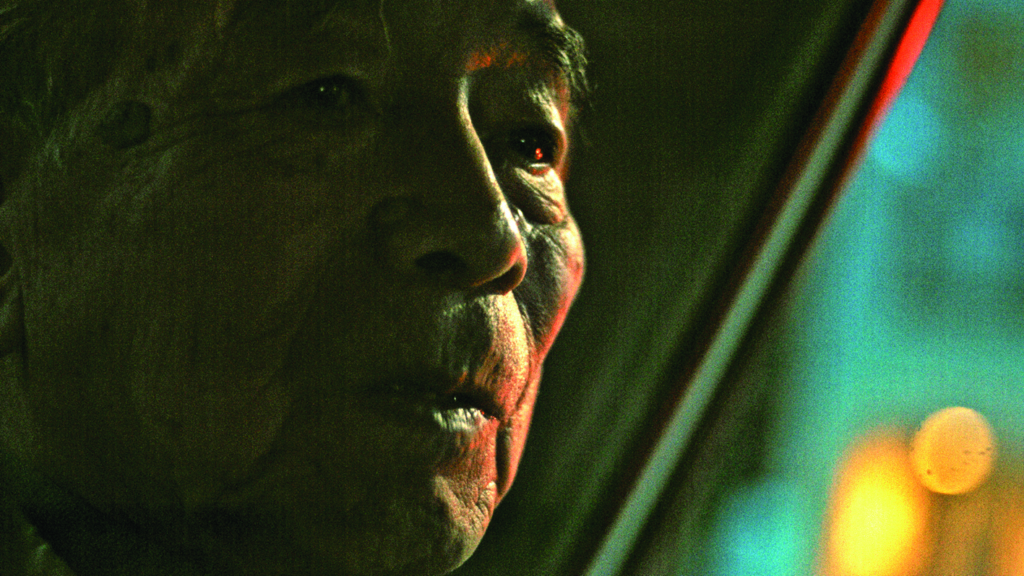
Australian filmmaker Adrian Francis’ documentary Paper City follows three such survivors – Hiroshi Hoshino, Michiko Kiyooka and Minoru Tsukiyama, who were between the ages of fourteen and twenty-one when the Tokyo raid occurred, and were in their late eighties and early nineties at the time of filming – who have been campaigning for this acknowledgement for much of their lives. Their work ranges from activities undertaken at a neighbourhood level to legal campaigns of national significance: educating the public; cataloguing the names of victims; seeking reparations from the government; joining other survivors in lobbying for a dedicated memorial to be built.[6]For an excellent summary of the campaigns pursued by firebombing survivors over the years, see Cary Karacas, ‘Fire Bombings and Forgotten Civilians: The Lawsuit Seeking Compensation for Victims of the Tokyo Air Raids’, The Asia-Pacific Journal: Japan Focus, vol. 9, issue 3, 2011, <https://apjjf.org/2011/9/3/Cary-Karacas/3474/article.html>, accessed 9 August 2021. In between these pursuits, they share their traumatic experiences of the firebombing both from inside their homes and during visits to locations around the city that no longer bear any trace of what happened.
Despite their longstanding struggle against bureaucratic and cultural indifference, the survivors are remarkably forbearing. In their old age, they seem driven less by anger or injustice than by a desire for their history to be recorded and passed on to future generations. (Hoshino, who has been at the forefront of the movement for decades, has been referred to elsewhere as a ‘memory activist’.[7]See ibid. The term was coined by academic Carol Gluck in ‘Operations of Memory: “Comfort Women” and the World’, in Sheila Miyoshi Jager & Rana Mitter (eds), Ruptured Histories: War, Memory, and the Post–Cold War in Asia, Harvard University Press, Cambridge, MA & London, 2007, pp. 47–77.) Paper City feels designed according to their wishes: it observes the survivors at their pace and lets them do the talking. Though Francis is sometimes heard politely asking a question or seeking clarification from off screen – he speaks Japanese well, having lived in Tokyo for the best part of two decades – he never imposes his views, other than to express compassion for his subjects through the way he films them. The tight framings and shallow focus of the images consistently prioritise the survivors over their surroundings – as a result, Tokyo has rarely looked so subdued on screen – while the frequent emphasis on their aged hands pays tribute to their resilience, much in the same way that Kiyooka admires the surface of an old ginkgo tree that was damaged in the fires but remains standing. Throughout the film, the camera stays close – unusually so, in fact, but nevertheless in a manner that is always marked by respect.

Paper City initially promises a different kind of film when it opens with a historical prologue showing B-29 pilots preparing for the raid, the jaunty accompaniment of Don Baker’s ‘There’ll Be a Little Smokio in Tokio’ on the soundtrack creating an irony suggestive of a Michael Moore documentary. Though the mood quickly shifts – the tune recedes and is replaced by Simon Walbrook’s ambient score, striking a mournful tone that is maintained for the rest of the film – Francis continues to make regular use of archival footage in the early sequences (for example, by juxtaposing shots of contemporary Tokyo with footage of similar locations taken from the aftermath of the raid). The film then settles into an observational mode and grounds itself firmly in the present. Archival materials occasionally appear thereafter, but mostly in the form of photographs the survivors themselves are shown looking at.
Some of these materials are graphic and distressing – Hoshino is seen studying a photograph of a Tokyo street littered with charred corpses[8]The image was taken by police photographer Kōyō Ishikawa, the only person to have captured the immediate aftermath of the raid. – but the terror of the firebombing, as experienced from ground level, is left mostly to the imagination. Taking his cue from Tsukiyama’s description of the raid, Francis cuts to images of fireworks to evoke the sight of incendiaries falling from the sky. Similarly, only a single shot of the water’s surface is used to visualise Kiyooka’s survival in the Sumida River, where she doused her body throughout the night to prevent it from catching alight (her father and older sister, who had accompanied her, both drowned). The poetic indirectness makes the horror easier to digest, but is in keeping with one survivor’s intimation that their experiences can never be properly conveyed. (‘It’s easy to say “13,000”,’ he relates, referring to the number of bodies that were buried in a mass grave. ‘But you can hardly imagine.’) Indeed, Tsukiyama makes the sobering claim that many of the city’s inhabitants refuse to believe that the raid even happened.
The ‘paper’ of the title alludes to the material used in traditional Japanese homes, the combustibility of which made the firebombing all the more destructive. But paper takes on many other forms in the film besides: a fold-out map displaying the damage inflicted on the city; a petition ceremoniously handed over by a group of survivors; a scroll inscribed with the names of the dead from a particular neighbourhood; the documents piled ceiling-high in the office of an organisation representing victims’ families;[9]The organisation is called the Association of Bereaved Family Members of Tokyo Air Raid Victims and was established by Hoshino in 2000. See Karacas, ‘Fire Bombings and Forgotten Civilians’, op. cit. an envelope held by Tsukiyama in the film’s opening shot. The motif is also made verbal by Kiyooka – who remarks that ‘the line between life and death is paper-thin’ – and reinforced, albeit somewhat heavy-handedly, in the stylised extreme close-ups of a calligraphy brush that are placed throughout the film in the manner of chapter headings.
The recurring emphasis on paper underlines not just the modest methods and materials used by the survivors, but also the frailty of the memories and history they’re trying to preserve. The cumulative impression is that their life’s work could go up in flames with a single spark. The analogy hasn’t been forced into the film, but emerges organically from its context. Most of Paper City was filmed over a two-year period that included the seventieth anniversary of the Tokyo raid in 2015 – an occasion the survivors see as a final opportunity to gather public momentum before there’s nobody left to tell their tale. Wherever they’re campaigning, the room is composed almost entirely of elderly men and women, many of them in their twilight years. Already so few in number and with no apparent heirs to take over once they’re gone, the survivors know that time is running out.
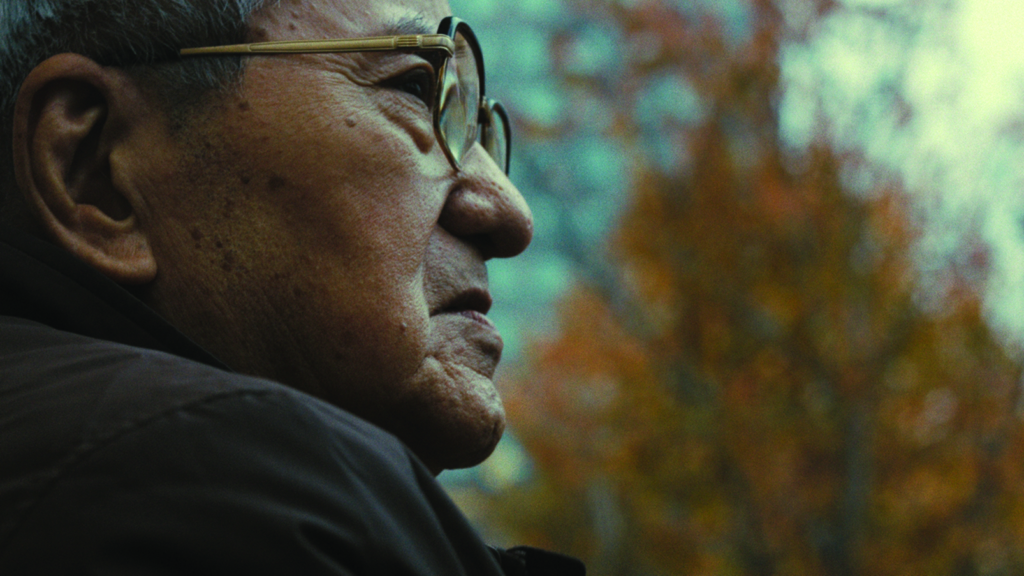
The separation between generations – young and old, past and present, wartime and postwar – is palpable throughout Paper City. Many of the locations look as though they belong to a Tokyo of old, trapped in time, an impression accentuated by cinematographer Brett Ludeman’s earthy tones and high-contrast images. Tsukiyama’s bric-a-brac shop seems to have barely changed in the six decades it’s been standing, and Hoshino and his wife’s wooden home resembles pre-war Tokyo architecture more than it does the concrete buildings that make up the city today. It’s also significant that, outside the scenes of survivors campaigning, Tokyoites are rarely seen – or, rather, they’re rarely shown clearly, because they tend to be filmed from behind or afar, glimpsed only as backdrop or literally obscured by the aforementioned use of shallow focus. The distance between the survivors and the city’s other inhabitants can be felt even when they come into close proximity. When Francis films a conversation with Hoshino in a taxi and momentarily cuts to the back of the driver’s head, we’re prompted to wonder how the man might be responding to his passenger’s heartbreaking anecdotes – or whether he’s even listening.
It’s significant that, outside the scenes of survivors campaigning, Tokyoites are rarely seen – or, rather, they’re rarely shown clearly, because they tend to be filmed from behind or afar.
Francis learned of the Tokyo firebombing while living in the city, but only through a film: Errol Morris’ The Fog of War (2003).[10]See Susan Rogers Chikuba, ‘Paper City: A Close-up View of the Tokyo Firebombing’, artscape Japan, 15 May 2020, <https://artscape.jp/artscape/eng/focus/2005_02.html>, accessed 9 August 2021. In this Academy Award–winning documentary, former US defence secretary Robert S McNamara is interviewed about his views on modern warfare and his role in some of the major military conflicts of the twentieth century. In a key sequence, McNamara proposes that the indiscriminate bombing of Japanese civilians was a disproportionate and immoral act of war, and that both he and air force general Curtis LeMay – the chief architect of the firebombing campaign, and an infamous figure in his own right – would have been tried as war criminals had the US not emerged victorious. In fact, LeMay also admitted years ago that his actions constituted a war crime in everything but name. ‘Killing Japanese didn’t bother me very much at that time,’ he remarked. ‘I suppose if I had lost the war, I would have been tried as a war criminal. Fortunately, we were on the winning side.’[11]Richard Rhodes, Dark Sun: The Making of the Hydrogen Bomb, Simon & Schuster, New York, 1995, p. 20.
Neither LeMay nor McNamara are mentioned in Paper City, which isn’t entirely surprising given that these historical figures fall well outside the immediate scope of the survivors’ agendas. What is surprising, however, is that the film turns out to be uninterested in situating the firebombing in a historical context. Other than through some basic information offered in the opening captions, there’s virtually no explanation provided about the events that led up to the raid, or about what happened after; likewise, there’s no attempt to examine the cultural and political factors behind the public’s postwar amnesia, despite this being ostensibly one of the central themes of the film. Even more unexpected is that the United States – the country that dropped the bombs in the first place – goes practically without mention. The only time its name is heard, in fact, is when ultranationalists disrupt a street protest held by a group of survivors. Driving by in a black propaganda truck fitted with loudspeakers,[12]These trucks are a trademark of uyoku dantai (literally, ‘right-wing groups’), a loose network of ultranationalist groups, and are a common sight in the metropolitan centres of Japan. See Jack Heslehurst, ‘Make Japan Great Again: The Rising Tide of Japanese Ultra-nationalism’, Metropolis, 28 July 2017, <https://metropolisjapan.com/140003-2/>, accessed 9 August 2021. these counterprotesters reproach the survivors as ‘beggars’ for seeking compensation and demand that they instead head to the US embassy: ‘Japan didn’t drop the bombs. It was an American war crime!’

Many viewers might be bemused by the fact that the strongest criticism against the United States is voiced by a group that appears to be diametrically opposed to the survivors, who never even come close to offering such sentiments. Indeed, if these survivors hold a grudge, it’s against their own leaders, past and present – for waging a war that should never have been waged, for not stopping it when it could have been stopped, for sacrificing their fellow citizens and for failing to adequately acknowledge all of the above. These views are hardly the norm in Japan, and can be considered controversial, as Francis has recognised.[13]See ‘Paper City’, The Drawing Room, Radio National, 2 August 2021, <https://www.abc.net.au/radionational/programs/drawingroom/paper-city/13480406>, accessed 9 August 2021. This isn’t to say, however, that the survivors are under any illusion as to the savagery of the American firebombing, and there may be other compelling reasons why they’re choosing to pursue legal actions against their own state instead (for one, the San Francisco Peace Treaty, which Japan signed in 1951 with forty-eight Allied nations, prevents the United States from being held liable[14]Karacas, ‘Fire Bombings and Forgotten Civilians’, op. cit.).
Over the course of the film, it becomes apparent that the survivors’ struggles don’t just concern Tokyo, or even Japan. Their aims are much broader, and predicated on a desire for their victimhood to be seen as universal rather than unique.
Nevertheless, the protest scene hints at how messy and unproductive the discourse surrounding war responsibility can be in Japan. The ultranationalists are closed to the possibility that the survivors might also consider the firebombing to be a war crime – or that they may be at once the victims of the United States and of their own state, which ordered its citizens not to flee the fires but to stay and fight them, at the cost of countless lives (the final words heard from the truck – ‘We Japanese will never forget!’ – could well have been spoken by the survivors themselves). This simplistic either–or mentality regarding the war is hardly unique to the Japanese context. Francis has explained how, when growing up in Australia, he was taught a great deal about the atrocities committed by the Japanese military and next to nothing about the experiences of Japanese civilians.[15]See Francis, op. cit.; and Chikuba, op. cit. When it comes to the wartime past, everybody chooses the story that suits them.
Paper City is no different in this regard. If the film doesn’t address the big moral and historical questions relating to the firebombing, or to the war more generally, it’s because it chooses to prioritise the civilian experience above all else. To this end, it simply acts as if it were assumed that the firebombing was immoral and treats any further historical context as unnecessary. The documentary’s unwavering focus will likely expose it to criticism from various quarters: those who might suggest it ignores the suffering Japan inflicted on the peoples of other nations,[16]This accusation has been made against many notable Japanese anti-war films. See, for example, Chuck Stephens’ remarks about the historical elisions in Kon Ichikawa’s Fires on the Plain (1959): Stephens, ‘Fires on the Plain: Both Ends Burning’, The Criterion Collection website, 12 March 2007, <https://www.criterion.com/current/posts/473-fires-on-the-plain-both-ends-burning>, accessed 9 August 2021. For a broader critique of victim mentality in Japanese representations of the war, see Naoko Shimazu, ‘Popular Representations of the Past: The Case of Postwar Japan’, Journal of Contemporary History, vol. 38, no. 1, January 2003, pp. 101–16. or claim it absolves the United States for its wartime actions, or else decry the historical simplifications regardless of where their allegiances may lie. It’s fascinating to learn that Francis appears to have left out scenes that would have pre-empted such concerns, at least in part. An early write-up about Paper City (in its pre–rough cut stage)indicates the presence of footage showing the survivors meeting their counterparts from Chongqing – a Chinese city that Japanese forces assaulted relentlessly during the Second Sino-Japanese War, including through firebombing[17]See Saotome Katsumoto, ‘Reconciliation and Peace Through Remembering History: Preserving the Memory of the Great Tokyo Air Raid’, The Asia-Pacific Journal: Japan Focus, vol. 9, issue 3, 2011, <https://apjjf.org/2011/9/3/Saotome-Katsumoto/3472/article.html>, accessed 9 August 2021. – and expressing outrage over LeMay being awarded the First Class Order of the Rising Sun, one of Japan’s highest honours, in 1964 for his role in setting up the country’s postwar Air Self-Defense Force.[18]Chikuba, op. cit.

These omissions may read like an act of diplomatic fence-sitting on the part of the filmmaker, if not simply a glaring oversight. But they’re perhaps more indicative of a refusal to engage in long-running historical arguments about war responsibility that would bring no benefit to the survivors and what they’re trying to achieve. Such a refusal could be considered naive, if the survivors were not themselves so insistent that their suffering be seen as emblematic of wars in general, not just the one that made victims of them. Chisako Sugiyama, a 99-year-old woman who lost her left eye in the Nagoya firebombing, concludes her speech to a room full of survivors with her hope ‘to have a world without war’. In another scene, Hoshino holds up to the camera a photograph of a bombing victim: a little boy alone in an ambulance, his face covered in dust and blood. ‘I looked just like this,’ he suggests, but this child isn’t Japanese; he’s Syrian, and the image is a colour photograph taken in 2016 in Aleppo.[19]The famous image is of Omran Daqneesh, who survived a regime air strike on Aleppo during the (ongoing) Syrian civil war. See Elle Hunt, ‘Boy in the Ambulance: Shocking Image Emerges of Syrian Child Pulled from Aleppo Rubble’, The Guardian, 18 August 2016, <https://www.theguardian.com/world/2016/aug/18/boy-in-the-ambulance-image-emerges-syrian-child-aleppo-rubble>, accessed 9 August 2021. Over the course of the film, it becomes apparent that the survivors’ struggles don’t just concern Tokyo, or even Japan. Their aims are much broader, and predicated on a desire for their victimhood to be seen as universal rather than unique.
In its steadfast commitment to these survivors, Paper City can likewise be considered an anti-war film of broad scope – one that eventually transcends the specificity of its Japanese context, despite certain omissions suggesting the contrary. The knowledge that it was made with the subjects’ trust, by a filmmaker whose background would have once signified him as their enemy – and them, his – makes it all the more effective. We see Francis and Kiyooka meeting for the first time, introducing themselves to each other and then exchanging business cards, as is customary in Japan. Though he speaks the language, Francis sometimes isn’t quite able to communicate his point, as occurs in a sequence wherein Hoshino doesn’t understand a question and has to ask his wife to translate.[20]Francis has suggested that the biggest issues he faced during the production were to do with his ‘modest Japanese language ability’. See ‘Paper City – Q&A with Adrian Francis’, Melbourne International Film Festival website, 11 August 2021, <https://miff.com.au/blog/view/6677/paper-city-qa-adrian-francis>, accessed 12 August 2021. Paper City functions as a heartfelt plea that the horrors of war not be forgotten; it also stands as a record of one individual’s effort to understand a history he was never taught, as well as a country and a population among whom he has made his home. Through this effort alone, the filmmaker and the survivors’ united gesture for peace finds one of its most moving expressions.
I would like to thank Adrian Francis for clarifying some details about the film while I was preparing this article.
Endnotes
| 1 | Though ‘shitamachi’ literally translates as ‘downtown’, its etymology relates to the topographically low-lying areas of the city’s east and the fact that these areas were traditionally home to lower-class citizens. |
|---|---|
| 2 | The over-representation of these demographics is due to the fact that most fit young men had been enlisted to fight in the war and were not in the city at the time. See Robert D Eldridge, ‘The March 1945 Firebombing of Tokyo and the Immorality of War’, The Japan Times, 9 March 2020, <https://www.japantimes.co.jp/opinion/2020/03/09/commentary/japan-commentary/march-1945-firebombing-tokyo-immorality-war/>, accessed 9 August 2021. |
| 3 | See John Ismay, ‘“We Hated What We Were Doing”: Veterans Recall Firebombing Japan’, The New York Times Magazine, 9 March 2020, <https://www.nytimes.com/2020/03/09/magazine/we-hated-what-we-were-doing-veterans-recall-firebombing-japan.html>, accessed 9 August 2021. |
| 4 | The number of casualties surpassed those from the Allied firebombing of Dresden, which had occurred just weeks earlier, and even those from the immediate aftermaths of the atomic bombs dropped on Hiroshima and Nagasaki in the final days of the war, though these numbers are disputed. See Kate Connolly, ‘Panel Rethinks Death Toll from Dresden Raids’, The Guardian, 3 October 2008, <https://www.theguardian.com/world/2008/oct/03/secondworldwar.germany>; and Alex Wellerstein, ‘Counting the Dead at Hiroshima and Nagasaki’, Bulletin of the Atomic Scientists, 4 August 2020, <https://thebulletin.org/2020/08/counting-the-dead-at-hiroshima-and-nagasaki/>, both accessed 19 August 2021. |
| 5 | The one public memorial that exists, in Tokyo’s Yokoamichō Park, is controversial for its lack of an accompanying museum to contextualise the raids, and for sharing the site with the memorial for the victims of the 1923 Great Kantō earthquake, an altogether separate disaster. See Cary Karacas, ‘Place, Public Memory, and the Tokyo Air Raids’, Geographical Review, vol. 100, no. 4, October 2010, pp. 521–37. |
| 6 | For an excellent summary of the campaigns pursued by firebombing survivors over the years, see Cary Karacas, ‘Fire Bombings and Forgotten Civilians: The Lawsuit Seeking Compensation for Victims of the Tokyo Air Raids’, The Asia-Pacific Journal: Japan Focus, vol. 9, issue 3, 2011, <https://apjjf.org/2011/9/3/Cary-Karacas/3474/article.html>, accessed 9 August 2021. |
| 7 | See ibid. The term was coined by academic Carol Gluck in ‘Operations of Memory: “Comfort Women” and the World’, in Sheila Miyoshi Jager & Rana Mitter (eds), Ruptured Histories: War, Memory, and the Post–Cold War in Asia, Harvard University Press, Cambridge, MA & London, 2007, pp. 47–77. |
| 8 | The image was taken by police photographer Kōyō Ishikawa, the only person to have captured the immediate aftermath of the raid. |
| 9 | The organisation is called the Association of Bereaved Family Members of Tokyo Air Raid Victims and was established by Hoshino in 2000. See Karacas, ‘Fire Bombings and Forgotten Civilians’, op. cit. |
| 10 | See Susan Rogers Chikuba, ‘Paper City: A Close-up View of the Tokyo Firebombing’, artscape Japan, 15 May 2020, <https://artscape.jp/artscape/eng/focus/2005_02.html>, accessed 9 August 2021. |
| 11 | Richard Rhodes, Dark Sun: The Making of the Hydrogen Bomb, Simon & Schuster, New York, 1995, p. 20. |
| 12 | These trucks are a trademark of uyoku dantai (literally, ‘right-wing groups’), a loose network of ultranationalist groups, and are a common sight in the metropolitan centres of Japan. See Jack Heslehurst, ‘Make Japan Great Again: The Rising Tide of Japanese Ultra-nationalism’, Metropolis, 28 July 2017, <https://metropolisjapan.com/140003-2/>, accessed 9 August 2021. |
| 13 | See ‘Paper City’, The Drawing Room, Radio National, 2 August 2021, <https://www.abc.net.au/radionational/programs/drawingroom/paper-city/13480406>, accessed 9 August 2021. |
| 14 | Karacas, ‘Fire Bombings and Forgotten Civilians’, op. cit. |
| 15 | See Francis, op. cit.; and Chikuba, op. cit. |
| 16 | This accusation has been made against many notable Japanese anti-war films. See, for example, Chuck Stephens’ remarks about the historical elisions in Kon Ichikawa’s Fires on the Plain (1959): Stephens, ‘Fires on the Plain: Both Ends Burning’, The Criterion Collection website, 12 March 2007, <https://www.criterion.com/current/posts/473-fires-on-the-plain-both-ends-burning>, accessed 9 August 2021. For a broader critique of victim mentality in Japanese representations of the war, see Naoko Shimazu, ‘Popular Representations of the Past: The Case of Postwar Japan’, Journal of Contemporary History, vol. 38, no. 1, January 2003, pp. 101–16. |
| 17 | See Saotome Katsumoto, ‘Reconciliation and Peace Through Remembering History: Preserving the Memory of the Great Tokyo Air Raid’, The Asia-Pacific Journal: Japan Focus, vol. 9, issue 3, 2011, <https://apjjf.org/2011/9/3/Saotome-Katsumoto/3472/article.html>, accessed 9 August 2021. |
| 18 | Chikuba, op. cit. |
| 19 | The famous image is of Omran Daqneesh, who survived a regime air strike on Aleppo during the (ongoing) Syrian civil war. See Elle Hunt, ‘Boy in the Ambulance: Shocking Image Emerges of Syrian Child Pulled from Aleppo Rubble’, The Guardian, 18 August 2016, <https://www.theguardian.com/world/2016/aug/18/boy-in-the-ambulance-image-emerges-syrian-child-aleppo-rubble>, accessed 9 August 2021. |
| 20 | Francis has suggested that the biggest issues he faced during the production were to do with his ‘modest Japanese language ability’. See ‘Paper City – Q&A with Adrian Francis’, Melbourne International Film Festival website, 11 August 2021, <https://miff.com.au/blog/view/6677/paper-city-qa-adrian-francis>, accessed 12 August 2021. |
